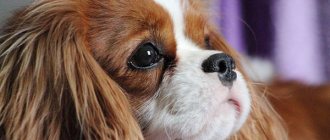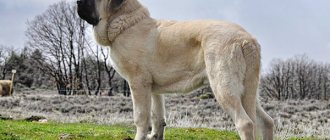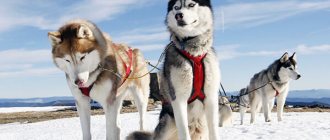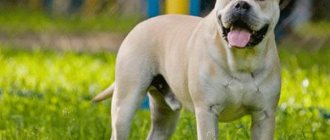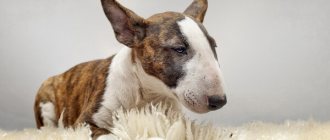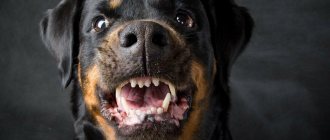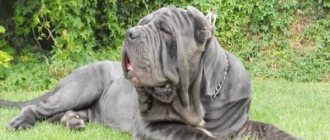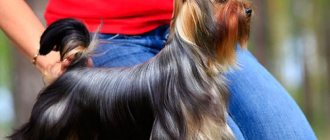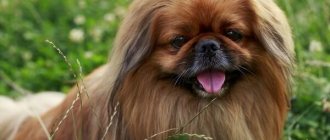Many people who like huskies, for one reason or another, cannot afford to purchase a pet of this breed.
Some people are put off by the rather large size of these dogs, while others are not satisfied with the fact that huskies are very active and need a lot of physical activity.
However, there is a way out - you can get not a standard husky, but a mini version of it.
Alaskan Klee Kais, as these dogs are called, are small in size and are much better suited for apartment living.
Description of the breed
The Alaskan Klee Kai is a small northern Spitz-type dog that resembles a standard husky in appearance. These dwarf dogs are intelligent, quick-witted and very energetic, but, unlike their larger relatives, they have never been used as sled dogs.
The Klee Kai's body is rectangular, with the withers and shoulder blades located above the loin and croup.
The head is wedge-shaped, with a slightly shortened, pointed muzzle. The eyes are preferably almond-shaped, medium set and slightly protruding. The ears are erect, triangular, with rounded tips, set quite high and close to each other.
The neck is of medium length and thickness, slightly arched. The chest is moderately deep, but not too voluminous. The back is straight and level, with a slight bend in the lumbar region.
The limbs can be quite powerful or appear light and graceful. The angles of the joints are correct, the hind legs are moderately wide.
The tail is lowered at rest, and in a state of excitement it is carried over the back and laid in a single or double ring.
The Klee Kai's coat is two-layered and very thick; it can be either quite short or long. At the same time, it is very important that in long-haired individuals the hair does not hide the outline of the body.
NOTE!
In fact, the Klee Kai is not a miniature husky. These are two completely different, although related breeds.
Where to buy and price
The Alaskan Klee Kai is a very rare breed of dog, so finding a kennel will not be easy. The queue for Russian puppies stretches for many months. It is easier to buy a baby abroad.
Less than a dozen nurseries are registered in Russia:
- Northern Moon (Ryazan);
- Song of Ice (Moscow);
- Victoria's Secrets (Moscow);
- Soloson (Moscow);
- Royal Pape (Moscow).
Alaskan Klee Kai puppies cost up to 340,000 rubles. Nicknames for boys: Archie, Barney, Zorro, Chip, Toy, Sparky. Nicknames for girls: Tessa, Pixie, Lynx, Minnie, Freya, Agatha.
History of appearance
Mini Huskies were bred in the 70s of the 20th century in the city of Wasilla, located in Alaska.
Klee Kai creator and breeder Linda S. Spurlin was interested in producing a smaller version of the standard Husky, but did not want the dogs she bred to exhibit signs of dwarfism and its attendant health problems.
In order to achieve this goal, she crossed Siberian Huskies with Alaskan Huskies, and later added the blood of American Eskimo dogs and Schipperkes to them.
From the early 1970s until 1988, Klee Kais were bred only in the kennel founded by the creator of the breed, until permission was received to breed these dogs by other breeders.
In addition, in 1995, the breed was divided into two varieties - regular Klee Kai and Alaskan. Their unification occurred in 2002, after the mini huskies were recognized by the AKC.
However, despite the fact that in America Klee Kais enjoy some popularity as companion dogs, the FCI and RKF have not yet recognized them as a separate breed. Such dogs do not have a standard and are not allowed at exhibitions except those held by organizations that recognize this breed.
Questions and answers
What is a mini husky called?
A mini copy of the sled dog is called “Klee Kai”. This name comes from the language of one indigenous tribe of Alaska - the Inuit. Translated, the word means “little dog.”
What size are mini huskies?
Pocket-sized Alaskans are divided into three groups based on height and weight. The largest Klee Kai (standard version) grows up to 43 cm and can weigh up to 10 kg. The next variety (mini) reaches 39 cm and 6.8 kg, and the tiniest (toy) is no higher than 34 cm and no heavier than 4.1 kg.
Character traits
Klee Kais are friendly, sociable and playful dogs. They do not need much physical activity, but they still love to run and play with their owners. Mini Huskies are able to sense the mood of their owners well and communicate with them accordingly.
However, Klee Kais do not tolerate being alone very well and therefore are not suitable as pets for busy people.
Mini Huskies are smart, quick-witted and obedient. They readily learn new things and therefore their training is not particularly difficult. Kli-kai are distrustful of strangers and, oddly enough, despite their small stature, they make quite reliable guards who can scare away a burglar who has entered the house with their barking.
Klee Kai love children and willingly play with them, but do not tolerate rough treatment or undeserved insults.
These dogs are not characterized by aggression towards fairly large animals: mini huskies are quite friendly towards other pets and rarely conflict with them.
However, for this, the dog must be properly socialized, since Klee Kais have well-developed hunting instincts, which is why it can hunt rodents and small birds.
Expert opinion
Kozhevin Semyon Kirillovich
Expert dog handler.
“Alaskan Klee Kais have a friendly and playful personality. They are devoted to their owners and are good at sensing their mood. Klee Kais are quite silent, but sometimes, like other northern breeds, they like to howl. They are distrustful of strangers and, in general, are less sociable than huskies. At the same time, Klee Kais do an excellent job of fulfilling their purpose: with proper upbringing, they become almost ideal family pets.”
Advantages and disadvantages of the breed
Charm, good nature, well-developed intelligence are only part of the advantages of the breed. Mini-huskies are not confrontational by nature. He will get along with the whole family, including other animals in the house. Dogs, hamsters, rabbits, guinea pigs and the rest of the “zoo”, with proper upbringing of the puppy, become part of the pack and do not cause aggressive intentions. Conflict can only happen with cats that are as independent as a small dog. But natural curiosity will sooner or later take over, and the cat and dog will become friends, contrary to the saying.
Klee Kai loves active and fun games and will happily frolic with children, but only on his own terms. The dog does not like noisy babies: they disrupt the established order and create too much noise. This makes our perfectionist nervous. Relationships with older children are more successful, but the mini-dog will not tolerate excessive pranks and disrespectful attitude toward himself.
The miniature husky breed is independent. On the one hand, this is not bad: an adult pet will not run its tail after its owner, demanding affection and attention. He is able to find something to do for himself. On the other hand, the independent nature of the baby affects training and education. The owner will have to take into account the wishes of the micro-husky. The best results are achieved by respectful treatment of the dog, requests, not orders. The Klee Kai strictly follows the established rules, but demands the same from the owner.
No matter how smart and obedient a small pet is, this nut is too tough for a novice dog breeder. Mini-huskies need training with a dog handler. An experienced owner can handle it on his own if he shows respect for the baby and is patient. A dog is not suitable for those who lead a sedentary lifestyle. Out of boredom, your pet will begin to look for adventures within the apartment. And he will definitely find it.
Advantages and disadvantages
pros
- Friendly.
- Loyal to their owners.
- Not prone to sabotage.
- They treat children well and play with them willingly.
- With timely socialization, they can get along with other pets.
- Well trained and obedient.
- Despite their small size, they can be good guards.
Minuses
- They cannot participate in exhibitions held by the IFF and RKF.
- They don't like to be alone.
- Sometimes they can start howling for no apparent reason.
- They love to dig the ground.
- They have great jumping ability: they can jump over a fence that is not too high.
- A rare and therefore very expensive breed of dog.
IMPORTANT!
Unlike most northern breeds, this dwarf breed does not need long walks or much physical exercise.
Mini Siberian Husky
Another “smaller” breed that is even more often confused with a Pomsky is the mini Siberian Husky , which is a miniature copy of the regular Siberian Husky.
Apart from their size, mini Siberians are no different from large huskies.
Origin story
The Mini Siberian Husky was first bred in the mountains of Hendersonville, South Carolina.
In June 2007 , the Mini Husky was born thanks to Bree Hefner May and other hobbyists who wanted a smaller breed that would be easier to handle.
The further development of this breed is under the supervision of Brie Hefner May, and matings are strictly controlled .
In other words, unlike the Alaskan mini-husky (Klee Kai), the Siberian mini-husky is the result of a natural mutation , without admixtures of other breeds. However, it is recognized as a separate breed.
Mini Huskies have the same color, coloring, body constitution, fur, tail, ears and muzzle as Siberian Huskies.
See photos of husky →
They are as smart, loyal and beautiful as Siberian Huskies, just half the size of the latter.
The weight of an adult mini-Siberian is 13-16 kg.
But the breeders do not plan to stop at the resulting size: the husky’s weight allows it to run, make long treks on foot, run in a dog sled and participate in competitions.
Photos of Siberian mini-huskies
#gallery-2 { margin: auto; } #gallery-2 .gallery-item { float: left; margin-top: 10px; text-align: center; width: 25%; } #gallery-2 img { border: 2px solid #cfcfcf; } #gallery-2 .gallery-caption { margin-left: 0; }
Content
Caring for Siberian Huskies, large and small, is similar.
However, a miniature dog needs less exercise and space in a house or apartment - it is perfect for keeping in the city .
Mini Huskies, like their larger counterparts, are usually in good health.
Problems may arise:
- with the eyes (cataracts, glaucoma, corneal dystrophy);
- older animals are susceptible to allergies and cancer;
- regular and mini huskies are susceptible to femoral dysplasia;
- You also need to watch out for obesity.
When walking, mini-huskies should be kept on a leash and not allowed to dig holes in the ground.
Character
The character of mini-huskies is the same as that of their regular-sized counterparts.
But, thanks to its size, the mini Siberian is easier to handle.
Huskies love communication and if they are constantly left alone, they can become very bored and depressed.
Sometimes mini huskies start barking for no apparent reason.
If this happens , it means the dog lacks attention from its owners or other dogs.
The Mini Siberian Husky will become a devoted and affectionate friend for anyone looking for a smart, beautiful, moderately active small dog.
Playful and playful mini-huskies can be given different endearing nicknames, taking into account their size: Bug, Totoshka, Kapitoshka, Murzilka.
What else can you call a dog →
A husky, no matter what size it is, is an amazing dog: smart, kind, and what’s more – it sings! And what huskies are like in the movies – you can’t take your eyes off them.
And it doesn’t matter whether the husky was reduced in size or crossed with a lot of other breeds - the external and internal beauty of this dog cannot be taken away.
Photos of color options
of colors are currently acceptable :
- Black and white.
- Grey-white.
- Red and white.
At the same time, black-and-white and gray-white dogs should have black pigmentation of the nose, as well as the edging of the eyelids and lips. For red and white mini huskies, the pigmentation of a dark brick or brownish-liver shade is desirable.
White markings are located in places strictly defined by the standard - on the head and muzzle, as well as on the neck, chest, limbs and stomach. In this case, it is desirable to have a narrow groove on the head, a closed mask and white eyebrows.
Not long ago, AKC was recognized as the standard for mini huskies and pure white color. However, individuals with this coat color are not yet allowed for breeding, even in their homeland.
Socialization
Due to the fact that the dog gets along well with children, he is often chosen by families who already have or are expecting a child. The dog will not offend the baby and is suitable for children in character, simply forcing the little family member to be active and play with his four-legged friend. This is very important for children with various developmental disabilities.
The Klee Kai breed gets along well with other animals, especially if they suit his liking. The dog can make friends on the site with other representatives of small breeds. But excessive activity can irritate reserved large dogs.
Nutritional Features
You can feed Klee Kais with both ready-made food and home-cooked food.
In the first case, the selected brand of food must correspond to the age, size, activity and physical condition of the dog. It is also very important that the food is of high quality - from premium class and above.
If the dog receives natural food, its diet should contain at least 30% protein products of animal origin. Best of all - meat or offal. In addition, it is necessary to give your pet raw or boiled vegetables, fermented milk products and rice, buckwheat or oatmeal.
NOTE!
Food for mini huskies should be fresh and prepared from good quality ingredients.
Feeding
For dog nutrition, it is better to choose super-premium food or immediately switch the animal to natural food. Cheap food will have a bad effect on your pet's body. A natural diet should include lean meat, vegetables, various cereals, fermented milk products, and lean fish (boiled). It is allowed to add well-cooked offal to food.
An adult animal is fed twice a day. It is recommended to give your pet special mineral supplements and vitamins so that he receives all the necessary substances.
In order for a mini-husky to grow well and be healthy, it needs to be fed properly.
It is forbidden to feed the dog river fish, potatoes, legumes, sausages and confectionery. You should not give your pet fried or smoked foods, and do not feed them from the table.
It is necessary to provide the dog with constant access to clean water.
Health and life expectancy
Previously, the Klee Kai was considered a very healthy breed and virtually free of genetic diseases. But many years of research have shown that this is not entirely true.
Despite the fact that for the most part mini huskies rarely get sick, they may be predisposed to some diseases, such as:
- Thyroid diseases.
- Autoimmune tyroditis.
- Cataract.
- Dislocation of the knee joint.
- Liver diseases.
- Pyometra.
- Cardiovascular diseases.
average lifespan
Suitable for living in an apartment or outdoors?
Klee Kais are equally suitable for keeping in an apartment or in rural areas. They have quite thick and warm wool, and therefore they can easily tolerate not too severe frosts and live outside almost all year round.
In the apartment, the mini husky behaves quite decently: when left alone, it does not howl and does not spoil things.
When keeping a pet of this breed in an apartment, you will have to regularly go for walks.
Which owner is it suitable for?
Representatives of this breed take root well both in a large and noisy family with small children, and in peace and quiet with single owners. It should be taken into account that pets do not tolerate loneliness and long-term separation from their owner; they begin to feel sad and even become depressed. The mini-husky is so cute, charming and temperamental that it can become the best friend for a person even with the most difficult character. The dog is endowed with excellent intuition and subtly senses when to involve the owner in a game and have fun, and when to leave him alone. In order to get such a puppy, physical training for marathon races is not required, the main thing is that the owner can take the pet for a walk, and there the dog will find how to entertain itself.
Education and training
You should start raising a puppy immediately after purchasing it. In addition, Klee Kais also need socialization, without which they can be aggressive towards smaller animals.
Pet training also begins from the first days of its appearance in the house.
First, mini huskies are taught to have a nickname and keep the house clean, and later they move on to the systematic study of commands:
- "To me". This command is easy to teach your pet if you say it while showing him a treat or a favorite toy.
- "Sit". A treat is shown to the dog and raised above its head, after which this command is given. When the Klee Kai reaches for food and sits down, you need to praise him and give him a treat.
- "Lie". You need to show your pet the treat and move it forward and down so that the dog, reaching for it, lies down.
- "Ugh". If a mini husky tries to pick something up from the ground, you need to say this command and if the pet does not obey, sharply pull the leash.
- "It is forbidden". Pronounced in a stern tone, in case of disobedience, physical action follows in the form of a light slap with a rolled up newspaper or a tug of a leash on the street.
- "Near". Using a leash, the dog is pulled towards the owner's left leg, after which you need to give a command and start moving, making sure that the Klee Kai walks alongside. If the pet resists, runs ahead or lags behind, you need to repeat the command in a more stern tone and pull the dog towards you again using a leash.
IMPORTANT!
The commands “Fu” and “No” should not be confused. The first means a ban on lifting something from the ground, while the second means a requirement to stop any unwanted action.
Appearance of an Alaskan Klee Kai
Toy, mini, standard
The Alaskan Klee Kai is a medium-sized dog breed with a harmonious and compact build. This is a charming baby with an expressive look, a “carnival” mask on his face and a tail playfully wrapped in a donut.
The standard provides for three types of dogs.
- Standard. The height of the animal at the withers varies between 38-45 cm, weight - 7-10 kg.
- Mini. The dog's height reaches 33-39 cm. Klee-kai weigh from 5 to 7 kg.
- Toy. The height of the animal is surprisingly small: up to 33 cm. The weight of these living toys corresponds to their parameters and does not exceed 4 kg.
Head and skull
The shape of the head is closer to a triangle than a wedge. Its integument is distinguished by the absence of skin folds. The forehead is rounded, the occipital protuberance is moderately expressed. The skull tapers towards the nose.
Muzzle
The muzzle of the Alaskan Klee Kai is slightly elongated. Its main distinguishing feature is the “mask”, which contrasts with the main color. The forehead of the Kli-kai is slightly longer than the bridge of the nose. In comparison with the latter, the shape of the nose is quite smooth, and the lobe itself seems convex. Pigmented black (sometimes with a soft pink stripe). The stop is characterized by moderate depth and smooth outlines. The cheeks are plump and dense. The lips are adjacent to the jaws, so the animal does not appear ruffled. Pigmentation in black or liver shade is acceptable. The latter is possible only for dogs of white and red color.
Ears
Alaskan Malamute and Alaskan Klee Kai
The ears of the Alaskan Klee Kai are two neat triangles, set close and quite high. Their tips are smoothly rounded. When looking at a dog, one gets the impression that its ears are disproportionately large in comparison with its head, but this is how it should be. The ears are open and wide, distinguished by dense fur on the outside.
Eyes
Non-convex, medium size. They have an oval, almond or round shape. The iris can be pigmented in various colors, but amber, blue or brown are the most preferred options. Klee Kais are often found with different eyes (a manifestation of heterochromia), but this is by no means a breed defect. A dark eyelid is required.
Jaws and teeth
The lower jaw is stronger and more powerful than the upper jaw. Scissor bite. The teeth fit tightly in the jaw. The enamel is strong and white.
Neck
The dog's neck looks graceful, has a smooth curve and is of medium length. When moving, the Alaskan Klee Kai keeps it extended, thereby bringing its head forward. The rest of the time the neck is “set” straight.
Alaskan Klee Kai muzzle
Frame
The case has a rectangular format. In profile, it becomes noticeable that the height of the animal is less than the length of the body. The level back turns into a strong lower back (a slight bend is noticeable in this place). The chest protrudes forward thanks to the oval front part. Compared to the shoulder line, the Klee Kai's pelvis looks narrower. The stomach is tucked.
Tail
White Klee Kais
Set quite high in relation to the lower back and twisted into a full ring. It is preferable that the tip of the tail be dark in color. Lies perpendicular to the line of the spine or slightly tilted to one side. Covered with thick hair.
Forelegs
The limbs are quite elegant and thin, looking proportional to the body. Flexible and strong joints provide powerful propulsion. The elbows are placed parallel to the dog's body. The oval paws have developed pads, the space between which is “occupied” by thick hair.
Hind limbs
The thighs are moderately muscular, the angle of the knee joints is well defined. The paws are tightly gathered into an oval; have strong fingers that end in rough pads. The space between them is filled with long hair.
Movement style
The Alaskan Klee Kai moves smoothly and at the same time nimbly, without any unnecessary effort.
Coat
Alaskan Klee Kai with black base color
The Klee Kai inherited its long coat from the Husky. A thick undercoat is required, which supports the guard hair in an elevated position. Its absence is permissible only during seasonal molting. The collar and charming “apron” on the chest are formed by a more “stuffed” undercoat. Long hair is acceptable on the ears, lower body and tail, as well as on the back of the paws.
Color
The Alaskan Klee Kai breed standard allows for a variety of coat colors. The most common options are:
- gray – from light to dark;
- red, including “fawn color”;
- black.
Regardless of the base color, the dog's neck, chest, belly and paws are predominantly white. The “mask” on the face is a tone or two darker than the main color - another mark characteristic of Klee Kais. A symmetrical and closed pattern is preferable. A white stripe that visually divides the forehead (and partially the bridge of the nose) into two parts, and light “eyebrows” above the eyes are welcome.
Possible defects
Alaskan Klee Kai at a dog show
Defects in the Alaskan Klee Kai breed include any deviation from the standard. Among the most common are:
- “torn” and/or asymmetrical mask on the face;
- bulging and/or close-set eyes;
- underdeveloped chest;
- excessively long hair;
- the presence of skin folds;
- light pigmentation of the eyelids;
- sagging abdominal line;
- straight bite format;
- restricted movements;
- jagged lips;
- blunt muzzle;
- sharp stop.
Disqualifying defects are the same defects, but in a more aggravated form. In addition, they include aggressive or cowardly behavior, as well as cryptorchidism (undescended testicles in male dogs).
Rules of care
The coat, especially if the dog has long hair, needs to be brushed daily. During shedding, this procedure must be repeated several times a day, since otherwise it will not be possible to efficiently remove the abundantly falling out undercoat.
Klee Kais are bathed infrequently, only when necessary, and it is recommended to use special shampoos intended for dogs.
The dog's eyes, ears and teeth are cleaned as needed, although they should be examined every day. The ears are cleaned with cotton swabs, the eyes with cotton pads soaked in a special composition for cleansing them.
You usually take care of your pet’s teeth yourself, cleaning them while chewing on toys or treats purchased at a pet pharmacy. If plaque has formed, which cannot be removed in this way, then the dog’s teeth are cleaned with dog toothpaste and a toothbrush.
Claws, if necessary, should be trimmed with a nail clipper, but not with nail clippers and, especially, not with scissors.
Mini Huskies are very clean, in addition, they have the habit of washing themselves with their front paws, thanks to which they themselves keep their fur clean.
Care and maintenance of a dwarf husky
Caring for mini-huskies is quite simple. Clean cats rarely need to be washed. Babies do not have the characteristic “dog” smell, and with proper nutrition there is no untidy smell from the mouth. They love to take care of themselves and often spend almost an hour a day on this activity. The only place where dogs need help from their owner is washing their paws after a walk, especially in inclement weather.
Proper nutrition
You can feed your mini dog both natural products and ready-made high-quality formulas, but you cannot mix these two types of feeding. The dwarf pet eats everything from raw vegetables to porridge and bread. But we must not forget that this is still a descendant of a sled dog and it needs meat. Mini dogs happily eat boiled beef, sea fish, rabbit and turkey meat. You should not feed your dog fatty meats: pork and lamb. Children usually perceive chicken normally, but in rare cases there is an allergy to this product. Any sweets are prohibited.
Caring for the coat of a small Husky breed
The Klee Kai's fur is thick and quite long. It requires dry cleaning and regular combing. In normal times, two or three times a week is enough, but during the molting period you will have to repeat the procedure daily. You can bathe 2-3 times a year, but you will have to wash your paws often, especially after a very active walk. It is advisable to use dry shampoo to clean the coat and not do this unless absolutely necessary. It is enough to cut the wool a couple of times a year.
Teeth and eye care
Mini dogs love to dig into piles of dry leaves or other plant debris. After a walk, you need to check the ears and eyes for dirt or foreign particles. If necessary, wash ears and eyes gently with a lint-free cloth or cotton swab (no cotton swabs). For the eyes, you can use chamomile decoction or strong tea (cold).
Teeth usually do not need to be brushed, but feeding only soft foods may lead to plaque, tartar, or gum problems. As a preventive measure, special sticks are suitable for strengthening teeth.
Walking a small husky
Mini Huskies have a fast metabolism. This means that after eating the dog must be walked. Dogs need constant physical activity. Taking your pet out for a couple of minutes so that he can “do his business” is not an option for an active dog. You need long, and most importantly, varied walks. If possible, you should travel out of town with your pet more often or change your walking route. Clean dogs walk a mile away from foul-smelling piles of garbage, and this makes walking a little easier.
Dog mating
All breeders unanimously consider breeding mini-huskies an incredible challenge. The breed is new, finding a worthy partner is difficult and sometimes unrealistic. In addition, there are discrepancies in the standards of different cynological organizations: there is no common list of breed defects. An excellent solution is to travel with your pet to its historical homeland, America. But this option is not suitable for everyone. What remains is the search for a partner in nurseries with a proven reputation. The procedure itself is carried out only after checking the health of the dogs and deworming. Usually the action takes place on the boy's territory. The girl is ready for mating with the onset of the third heat.
Training and education of mini-huskies
A “small dog” puppy perceives anything smaller in size as prey. From the very first days, you need to make it clear to your pet that hunting other inhabitants (kittens, guinea pigs, hamsters, parrots, etc.) is strictly prohibited. Serious training begins at 4 months, and this may require the help of a specialist. Small puppies cannot yet overcome high obstacles or pull heavy objects, but keeping your pet occupied with something interesting is absolutely necessary. It is difficult for novice dog breeders to cope with an active and self-inflicted dog.
Diseases, vaccinations
Small decorative dogs only look fragile in appearance. They have behind them a string of persistent and hardy northern dogs with excellent health. Klee Kais rarely get sick. Problems can only arise with lack of exercise or overeating. Proper care and timely vaccinations are all a baby needs for a long and happy life.
The first vaccinations must be given by the breeder. Vaccination documents must be obtained upon purchase. Usually, a conscientious seller will give recommendations: what to vaccinate against and with what, and when. But it is better to contact a veterinarian immediately after purchase and entrust him with everything related to vaccines and vaccinations.
How to choose the right puppy?
You need to purchase Klee Kai only from a nursery. Moreover, since the breed is rare, you may have to wait quite a long time until the puppies that have not yet been reserved are born.
When choosing a baby, you need to pay attention not only to his appearance, but also to his character, temperament and state of health. The puppy must be active and playful, showing a friendly curiosity towards people and willingly communicating with other dogs in the kennel.
It is undesirable to adopt a puppy that shows aggression or cowardice - he will almost certainly have mental problems, which will subsequently greatly complicate his socialization and training.
NOTE!
Despite the fact that many nurseries provide such a service as delivery of the puppy to the buyer, it is better to go for the future pet yourself.
After all, it is not always possible to understand from a photograph how good a puppy’s exterior is. In addition, when buying a mini husky in this way, it will be impossible to check his psyche and temperament.
